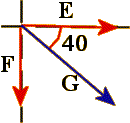| Summing the Components
Now that we have replaced all the bad vector with good vectors, we have a
much simpler system of vectors to sum. (But remember, this system of good vectors is
equivalent in every way with the system of bad vectors we started with.) We can
now begin to add the good vectors. Since vectors are easiest to sum when they point
along the same line (parallel or anti-parallel) we will add those vectors first.
There are two sets of such vectors -- those that point along the x-direction (the
horizontal line), and those that point along the y-direction (the vertical line).
You will probably find it convenient, especially when summing many vectors, to create a
table that sorts the good vectors according to direction.
At this point it will be easiest to refer to an example:


In the figure above, we are given two vectors, C and G,
to sum. For each vector we draw an x-axis and y-axis. For vector C,
the corresponding good vectors are denoted A and B and
are shown in the following figure. Notice that we also show the good vectors for
vector G, which we call E and F.
The length (magnitude) of vector A is given by
A = C X COS(60) = 10 X (0.500) = 5.00,
and for vector B,
B = C X SIN(60) = 10 X (.867) = 8.67.
For vector G we do the same:
E = G X COS(40) = 8 X (0.766) = 6.13,
F = G X SIN(40) = 8 X (0.643) = 5.14.

|
Why don't I get those numbers when I use my calculator! |
Now that we have nothing left but good vectors, we place them in a table according to
direction.
Original Vector |
x-direction |
y-direction |
C |
A |
B |
G |
E |
F |
The following is the same table, but with the lengths of the
vectors substituted for the symbols. Notice the sign convention: We use
negative to denote vectors that point to the left or down.
Original Vector |
x-direction |
y-direction |
C |
+5.00 |
+8.67 |
G |
5.14 |
-6.13 |
Now we take advantage of the fact that parallel vectors are easy
to add. Those vectors listed in the x-direction column (A
and E) point along the same direction, so we just add their respective
lengths and put that total at the bottom of the column. We do the same for the
y-direction for vectors B and F.
Original Vector |
x-direction |
y-direction |
C |
+5.00 |
+8.67 |
G |
+5.14 |
-6.13 |
|
+10.14 |
2.54 |
These vector sums at the bottom of each column are, naturally,
vectors. Essentially, we have reduced our problem of summing two bad vectors (C
and G) to a problem of summing two perpendicular vectors (X
and Y), and perpendicular vectors are much easier to sum. In
summary,
- X is a vector of length 10.14 that points to the right in the
x-direction
- Y is a vector of length 2.54 that points up in the y-direction
|